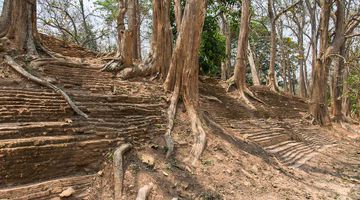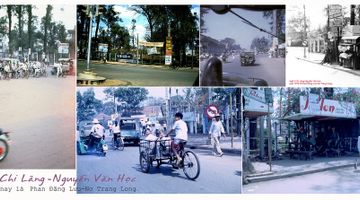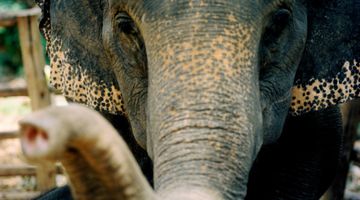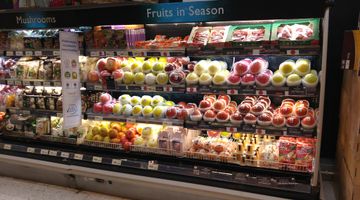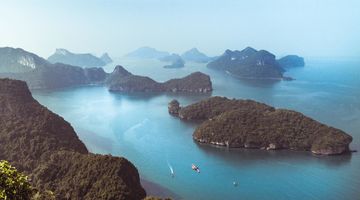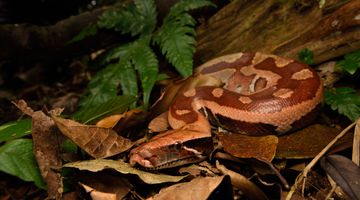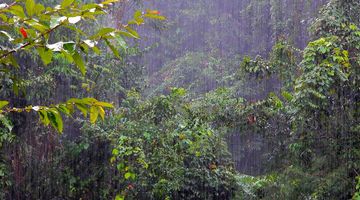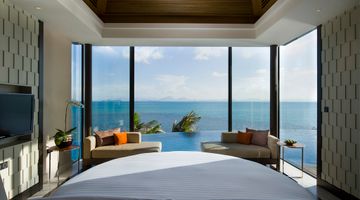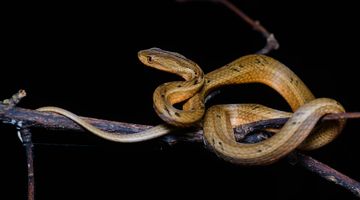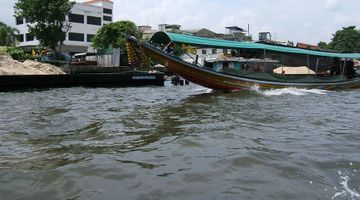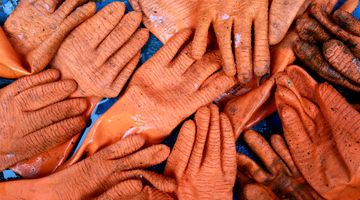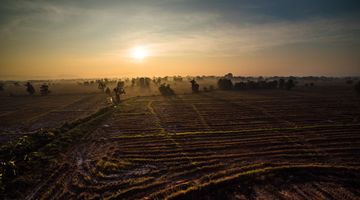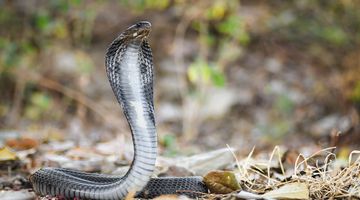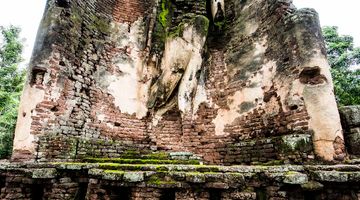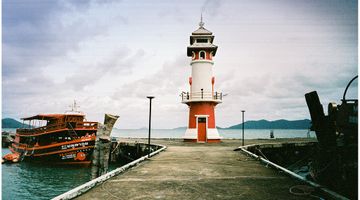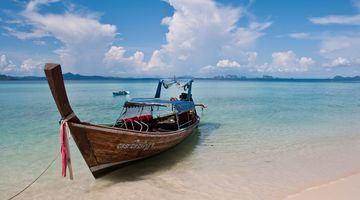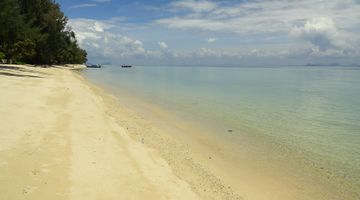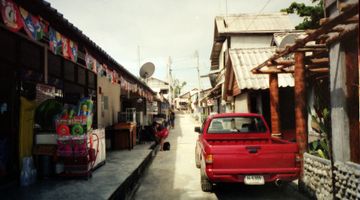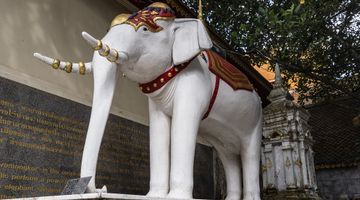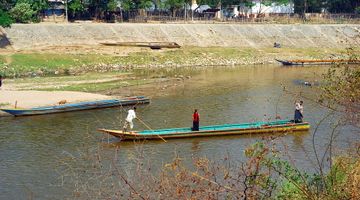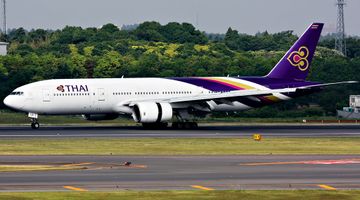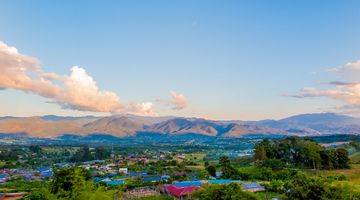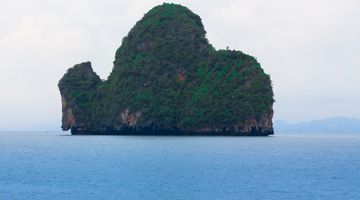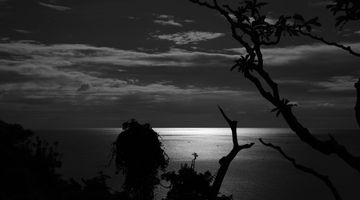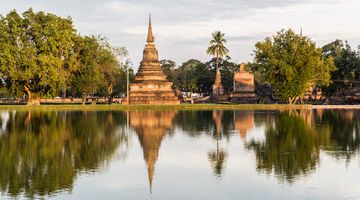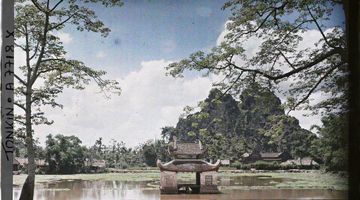Top 10 Most Colourful Festivals in Thailand Not to Miss
For travellers who want a sneak peek behind Thailand’s curtain of heritage and tradition, as well as travellers who just want an excuse for colourful, exuberant celebration, the festivals in Thailand are sure to enthral all. Envision a country-wide water fight with giddy children and adults running through the streets with water-guns and buckets of water; envision hundreds of candlelit paper-lanterns floating into the sky at night time – these are only two of Thailand’s festivals and events that call visitors to the vibrant and welcoming Land of Smiles.
What do the Thais celebrate?
Not only is Thailand home to exquisite beaches and palm-fringed coastlines, but it is also a destination that is saturated in fascinating culture and traditions that are profoundly influenced by spirituality and religion. There are many festivals that celebrate and pay respect to these captivating influences year-round in the kingdom; and visitors who enjoy the cultural inside scoop would do well to plan their trip accordingly. The festivals offer a glimpse into Thailand’s long-standing history and rich heritage; and while the majority of Thai festivals are cultural ceremonies, there are also certain celebrations that are specific to certain cities or regions. Offering intriguing insights into the religious beliefs and ancient customs, these celebrations also allow tourists to enjoy meaningful and enriching interactions with the locals.
Overflowing with vibrant colours, sacred customs and ancient rituals, these festivals and cultural celebrations are once-in-a-lifetime opportunities for travellers and will make any trip to Thailand unforgettable.
The top 10 most colourful festivals in Thailand are listed below in chronological order, from January until December, to make booking your tickets that much easier for festival enthusiasts. Please keep in mind that many Thai festivals are dated according to the lunar calendar which means that the exact date will vary slightly each year.
1. Chinese New Year (January or February) Bangkok
The biggest Chinese festival in Thailand is undoubtedly, the colourful and exhilarating Chinese New Year that occurs around January or February in Yaowarat (the Chinatown of Bangkok) depending on each year’s Chinese Lunar Calendar. Envision the street springing to life with throngs of worshippers, the iconic red Chinese lanterns, colourful performances, exploding firecrackers and exotic dragon dances. The fanfare extends further than the streets of Yaowarat, with Nakhon Sawan, Koh Samui, Chiang Mai and Phuket hosting temple celebrations, delicious Chinese banquets, food stalls and extravagant dragon parades.
The Chinese New Year is celebrated by the locals in the form of praying to the gods, partaking in big family feasts at home and paying respect to the ancestors. Free feng-shui advice is also given as well as big discounts and promotions in shopping malls.
Buy your tickets to the most colourful celebration of the next Chinese New Year in Thailand in Nakhon Sawan.
2. Chiang Mai Flower Festival (first weekend in February)
It doesn’t really get much more colourful than enormous, astounding floral displays that occur at the impressive Flower Festival in Chiang Mai on the first weekend of February. Picture an array of stunning floats adored with sweetly fragrant flowers in every imaginable colour, size and variety. This festival is surely one of the most special festivals in Thailand for those who love buds, blossoms and brilliantly designed flower arrangements. An exciting highlight of the Flower Festival is the dazzling parade that is held along Charoen Muang Road in Chiang Mai. The parade consists of flashy floats decked in multi-coloured flowers, drumming groups and twirling dancers dressed in colourful, traditional clothing.
Suan Buak Hat Park is also carpeted in gorgeous orchids, the local Damask Rose and rainbow-coloured chrysanthemums. The overpowering scent of aromatic flowers and the dizzying array of colourful blossoms are sure to impress all who attend.
Travel to Chiang Mai from Bangkok by air, train or bus.
3. Songkran (13th- 15th April; countrywide)
Songkran originates from the Sanskrit word meaning ‘passing’ or ‘approaching’. Thailand’s most important, most fun and most well-known festival, Songkran, is commonly referred to as Thailand’s Water Festival. A deeply significant event on the Buddhist calendar, Songkran marks the start of the traditional Thai New Year, but it is more commonly known throughout the world as being an exuberant and thrilling nation-wide waterfight. The giddy, pure happiness of everyone from toddlers and the elderly that are drenched from head to toe characterises this event. Everyone stops what they are doing for three days and throws buckets of water at each other, shoots sprays of water from balconies at passing motorbikes and celebrates with plenty of dancing, music and drinking. What began as a Buddhist tradition of lightly sprinkling water as a symbol of purification, slowly morphed into one of the best and most enjoyable of all the festivals.
4. Phi Ta Khon (June or July; Dan Sai, Loei Province)
Sometimes known as Ghost Festival, Phi Ta Khon is a festival completely unique to the sleepy Dan Sai district in Loei Province and symbolises the locals’ beliefs in spirits and ghosts. It is held annually as part of the magnificent festival known as ‘Boon Luang’ and is one of the biggest attractions to the little, farming village snuggled in the mountains of northeast Thailand. The dates are fixed at the first weekend after the sixth full moon and is recognised for its Halloween atmosphere of local men wearing decorated masks, raggedy robes and enacting the part of formidable ghosts. The festival also includes cheerfully taunting children who dance and tease the crowds of onlookers as well as merry, carnivalesque goings-on such as dancing, cheering and music playing.
Phi Ta Khon is not only one of Thailand’s most lively and colourful festivals, but it also allows visitors insight into the remarkable rites and beliefs of the locals. The festival is a sight to behold and is supposedly based on the long journey made by Prince Vessantara, which is said to be Buddha in a past life. After not returning from his journey for very long, his followers assumed that he had died until one day he returned alive and well. Legend has it that his followers rejoiced with such gusto and enthusiasm that they were said to have awoken the dead.
Fly or travel by bus from Bangkok to Loei.
5. Ubon Ratchathani Candle Festival (July)
This festival held in the Isan province of Ubon Ratchathani is one of the finest festivals that showcases the skills and talents of Thai artists and elaborate parades of people carrying intricate wax carvings to Buddhist temples, commonly known as wats, fill the streets of Ubon Ratchathani. The wax carvings are usually made from beeswax and are elaborately decorated with Thai and Hindu folklore characters and mythology. The candles symbolise the chasing out of gloom in preparation for the rainy season and the ethereal sight of the candlelit parade is a truly memorable experience for all. This visually stunning experience is an excellent way for visitors to fully appreciate a city filled with merriment and festive joy; as well as to learn more about Thai traditions and customs.
The candle procession occurs on July’s full moon which marks the beginning of Buddhist Lent and the candle sculptures are entered into a competition that artists from all over the world participate in.
Trains, buses and planes are ready to bring you from Bangkok to Ubon Ratchathani
6. Bang Fai Phaya Nak (Nong Khai Naga Fireballs; October)
In recent years a strange peculiarity has been occurring over the Mekong River in Nong Khai and has been drawing thousands of visitors from all over Thailand to its mystical riverbanks. It is said that each year on the night of October’s full moon, soundless, vapourless fireballs materialise on the river as little, pinkish, floating spheres that float up to heights of 30 meters and then vanish from sight. Some years have only a handful of these fireballs, other years have thousands. An unconfirmed scientific theory suggests that the fireballs are a combination of nitrogen and methane that reach a specific temperature at that time of year and get released into the air; dreamers and romantics however, believe that the river nagas (serpents) breathe out these fireballs in an attempt to call Buddha to return to earth once Lent has passed.
The odd occurrence has now begun a two-day festival of Bang Fai Phaya Nak and regardless of the source of these fireballs, the spectacular and puzzling sight is a good enough reason to visit Nong Khai during October.
Nong Khai can be reached from Bangkok by plane, train or bus.
7. Phuket Vegetarian Festival (October)
The name of this celebration does nothing to suggest the gory and grisly activities that accompany this unusual festival that might be one of the most bizarre and shocking in all of the country. The festival celebrates the Chinese community’s belief that abstaining from eating meat during the ninth lunar month of the Chinese calendar will be rewarded with excellent health and peace of mind. Other than abstaining from meat, many locals walk barefoot on coals and voluntarily pierce their faces and body parts with an assortment of peculiar and gruesome objects in an attempt to purify their souls. The parade of mutilated people in trace-like states are accompanied by fireworks, drums and offerings to the gods. There is also a delicious abundance of vegetarian cuisine for those who are not squeamish. This festival, while fascinating and captivating, is not for the fainthearted.
We will bring you from Bangkok to Phuket fast or cheap!
8. The illuminated boat procession or 'Lai Ruea Fai' (11th lunar month; Nakhon Phanom)
Held in celebration of the end of Buddhist Lent and Buddha’s return to earth, the yearly Lai Ruea Fai festival, or illuminated boat procession, is one of the most famous celebrations in northeast Thailand held in the city of Nakhon Phanom. Highlights include decorated boats filled with thousands of lit candles, flowers, incense and paper lanterns that get set alight and launched down the Mekong River at night. Other fun activities of Lai Ruea Fai include scrumptious food stalls, fireworks, religious offerings, dancing and cultural performances. The atmosphere of this festival is one of great delight and excitement and well worth a visit during any holiday to Thailand.
Bus or fly from Bangkok to Nakhon Phanom.
9. Loi Krathong Festival (November; countrywide)
A breathtaking sight to behold, Loi Krathong is a visual paradise of thousands of twinkling candlelights that span across rivers and dot the sky like brightly lit stars. Known as the Festival of Lights, this event is held every year on the evening of the 12th month in the Thai Lunar Calendar. This spiritual, ancient festival is to celebrate and honour Buddha and the goddess of the river, and is enthusiastically celebrated throughout the country with dazzling parades, colourful festivities and beautiful concerts. The most significant aspect of this festival is the releasing of krathongs. A krathong is a small, lotus-shaped floating vessel often made from banana leaves that are then decorated with flowers, incense, candles and somethings even a fingernail clipping or lock of hair, to express their gratitude to the water goddess and to release any grudges and bitterness of the year.
Loi Krathong corresponds with the Yi Peng festival that occurs in Chiang Mai, where thousands of candlelit paper lanterns (Khom Loi) are released into the sky creating a truly spectacular sight.
Why not check one of the most celebrations of Loi Krathong in Thailand in Chiang Mai, Sukhothai or Ayutthaya?
10. Lopburi Monkey Banquet (November)
This festival is exactly as the name suggests – a massive feast of tropical fruit, rice and salad all for the monkeys of Lopburi to indulge in. And indulge they do! Long tables are adorned with food and the guests of honour are of course, the long-tailed macaques who have become significant members of Lopburi and intermix with locals in everyday life. This is done out of the belief that good luck will follow from treating the furry creatures with respect. A monkey food fight is also not an uncommon sight! Unusual, unique and memorable – what more could you ask for?
Getting to Lopburi is easy – by train or bus.
Tips for visiting during festivals
-
During certain festivals that carry great religious or spiritual meaning it is advised to not dress provocatively out of respect for the sacredness of the event.
-
It is advisable to book flight tickets and accommodation well in advance as spaces fill up quickly.
-
Educate yourself on the customs and meanings of the festivals prior to attending to get the most out of the experience.
-
Be respectful to the locals’ beliefs and considerate of the customs and ceremonies.
-
Be mindful of taking photographs during sensitive parts of the festivities especially during the more spiritual or religious celebrations.
-
During Songkran make sure that your cellphone, money and passport are in a waterproof container if travelling with these items on the streets.










